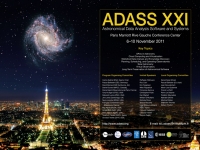Data mining on ice
Tim Ruhe (TU Dortmund),
Prof. Dr. Katharina Morik (TU Dortmund)
Abstract
IceCube is a cubic kilometer neutrino telescope
located at the geographic South
Pole. The detector consists
of 5160 Digital Optical Modules (DOMs) installed on
86
vertical cables (strings). The main scientific goal of IceCube is the
detection of
neutrinos from extragalactic sources like
Active Galactic Nuclei and Gamma Ray
Bursts. For the
detection of such sources however, a detailed understanding of
the
atmospheric neutrino spectrum is crucial. These
atmospheric neutrinos are produced
in cosmic ray air
showers. The detection of atmospheric neutrinos is hindered
by
atmospheric muons entering the detector from above. A
first rejection of background
can be achieved by using the
earth as a muon shield and selecting upward going
tracks
only. A small fraction of atmospheric muons however, is still
misreconstructed
as upgoing. Due to the small interaction
cross section of neutrinos the number of
misreconstructed
muons exceeds the number of actual neutrino events by
roughly
three orders of magnitude at the analysis level. The
low signal to background ratio makes this task well suited for
a
study within the scope of machine learning. Detailed
studies have been carried out in
order to achieve the best
possible separation of signal and background. Our
studies
extend from detailed parameter selection and
parameter construction to detailed
investigations of diverse
classifiers. Monte Carlo simulations as well as real
data
were used.Slides in PDF format
Paper ID: O24
|

